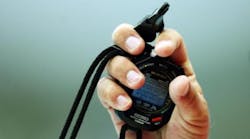Solution (see below for original puzzle): Schmaltz's mistakes:
1. When calculating the savings he overestimated (to his benefit) because a number of tools had already been processed by the end of of the first day when he was going to give his recommendations to Blasterbutt. Schmaltz figured on 200 sticks, but there were only 128 left. (assuming an 8 hour shift. If overtime was used there would have been even less)
2. Schmaltz didn't add his costs to the project. His time should have been figured in just like Ed's (and I'm sure he made a lot more pay)
Ed's recommendations:
Get rid of Schmaltz immediately and bring in one more worker from another unit so that he and Ed could form a new team. Or, have Smaltz take off his Ray-Bans and pitch to form a new team with Ed (if the union would allow it). Either way, the man hours per stick goes down because everyone being paid is doing something useful. The total project time and cost to process all the tools go down because there would be four teams instead of three.
Puzzle: Ed supervises the live line storage facility at Hinterland Electric. Following a large storm with many outages and restorations, Ed ended up with a large number (200) of tools that need to be cleaned and tested so they can be safely put back in service. A task this size with so much time pressure has never happened before at Hinterland. So, by management orders, Ed and his team are being monitored by a consultant, a Dr. Schmaltz who has been specially contracted to monitor employee efficiency until the job is done.
Arriving the first day of testing, Schmaltz monitors the process, standing in the yard with his hard hat, sunglasses and sunblock. In the afternoon heat he monitored the work from his company-provided car, with the engine running and the AC on.
Dr. Schmaltz notes that Ed has 3 teams of two workers each. It takes a team of 2 to take each tool from the bucket truck, carry it across the hot yard to a shaded work area that’s under an overhang too low for the bucket trucks to enter. Then each tool is cleaned, inspected and electrically tested, and returned to the truck. Ed helps out wherever he can, often relieving one of the workers so they can take a break and get some water. It’s summertime and hot but the workers move rapidly, knowing that the work is critical. The whole process averages 20 minutes for each tool. So Schmaltz quickly calculates that it takes about .67 man-hour to clean each stick, not counting Ed’s time. But he does have to account for Ed so it really comes out to .78 man-hours. Since there are 200 tools to be cleaned it will take 156 man-hours to clean them all.
Finally, at the end of his first day, Dr. Schmaltz calls Ed to one side and tells him that he has a way to make the operation more efficient. Ed wipes his brow and listens. “It’s quite simple, actually,” Says Schmaltz. “I’m going to recommend to the Chief Operating Officer, my friend and neighbor Mr. Blasterbutt, that rather than carrying these things (whatever they are) all the way to the shade under the overhang, the workers set up to clean and test them in the open, near the truck. They won’t need to carry them back and forth, which will save 2 minutes per item! See, I’ve timed them with this!” Schmaltz proudly shows Ed his portable Cesium stop watch. “That’s a 10 percent savings in time per stick. So my recommendation will save about 16 man-hours for the whole job.”
Ed thinks for a minute and puts his arm around Dr. Smaltz. “I don’t want to hurt your feelings, doctor, but you must have missed learning arithmetic while getting your PhD.” Ed says kindly. “You made at least 2 errors in your calculations.”
Smaltz’s eyes narrow behind his Ray-Bans as he shakes off Ed’s arm. He’s clearly upset, but Ed continues. “My son mows Mr. Blasterbutt’s lawns and he’s over there now with a note from me. I’ve come up with a suggestion that would save a whole lot more money and also more total job time than what you’re recommending.”
After Ed tells him what he wrote in the note, Schmaltz stomps off to his car and peels out of the yard, never to be seen by these workers again.
(Epilogue: Schmaltz eventually came to the conclusion that he just wasn’t cut out to be an efficiency consultant. He now operates a small tool rental company just outside of Edmonton, Canada. Mr. Blasterbutt retired soon after this incident. Ed was promoted a number of times, eventually ending up, as of this writing, as Chief Operating Officer of Hinterland Electric whose proud motto is “Connecting You From Here To There!”)
What were Schmaltz’s errors? What was Ed’s suggestion? Best complete answer wins a $50 gift card. (Register on tdworld.com and leave your answer in comment box below. Please make sure you follow up with verification of the registration through email so we can find you.)



